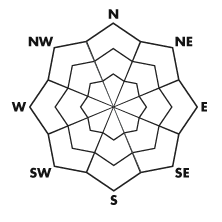


| Advisory: Ogden Area Mountains | Issued by Drew Hardesty for February 17, 2013 - 6:42am |
|---|
























 
Above 8,500 ft.
7,000-8,500 ft.
Below 7,000 ft.
|
bottom line It's mostly LOW danger. An isolated pockety MODERATE still exists:
|
 |
current conditions Skies are overcast ahead of what looks to be a quick-hitter cold front later this morning. It'll be mostly a brush-by to the north and we'll pick up a couple traces of snow for the effort. Ahead of the front, winds are west to southwest, blowing 15-20mph with some of the higher elevation anemometers registering gusts into the 40s. Overnight lows are in the upper 20s to low 30s with a few stations in the mid elevations showing little to no refreeze. That's ok - after frontal passage, things should lock up pretty well, as temps dive to the upper single digits to low teens. Riding conditions remain quite good in the northerly sheltered terrain. Who could complain? |
 |
recent activity It's like the Island of Misfit Toys. A few minor wet and dry sluffs, a cornice induced 1' deep and 100' wide soft slab high in the Ogden mountains, a shallow skier triggered wind slab 75' wide in east facing terrain at 9200' in the Ogden area mountains; a natural hard slab at 11,000' in Provo 1' deep and 100' wide with timing unknown, |
| type | aspect/elevation | characteristics |
|---|
 |
























 
Above 8,500 ft.
7,000-8,500 ft.
Below 7,000 ft.
|
|
|
description
A few comments about the few concerns for today:
|
 |
weather We'll be back to winter in the blink of an eye. The tulips, crocuses and zinnias will have to wait. Temps dive with the day's cold front. Clearing skies for tonight and tomorrow ahead of the 1st in a series of cold Pacific storms due to arrive later Tuesday...sticking around through later Thursday. It bears some resemblance to last weekend's closed Low that moved overhead and brought a foot of snow. Moderate to strong southerly winds precede things on Tuesday. The next storm moves in through the weekend with the active pattern likely continuing through early next week. |
| general annoucements Go to http://www.backcountry.com/utah-avalanche-center to get tickets from our partners at Park City, Beaver Mountain, Canyons, Sundance, and Wolf Mountain. All proceeds benefit the Utah Avalanche Center. If you trigger an avalanche in the backcountry - especially if you are adjacent to a ski area – please call the following teams to alert them to the slide and whether anyone is missing or not. Rescue teams can be exposed to significant hazard when responding to avalanches, and do not want to do so when unneeded. Thanks. Salt Lake and Park City – Alta Central (801-742-2033), Canyons Resort Dispatch (435-615-3322) Ogden – Snowbasin Patrol Dispatch (801-620-1017) Powder Mountain Ski Patrol Dispatch (801-745-3772 ex 123) Provo – Sundance Patrol Dispatch (801-223-4150) Dawn Patrol Forecast Hotline, updated by 05:30: 888-999-4019 option 8. Twitter Updates for your mobile phone - DETAILS Daily observations are frequently posted by 10 pm each evening. Subscribe to the daily avalanche advisory e-mail click HERE. UDOT canyon closures UDOT at (801) 975-4838 Wasatch Powderbird Guides does daily updates about where they'll be operating on this blog http://powderbird.blogspot.com/ . Remember your information can save lives. If you see anything we should know about, please participate in the creation of our own community avalanche advisory by submitting snow and avalanche conditions. You can also call us at 801-524-5304 or 800-662-4140, or email by clicking HERE Donate to your favorite non-profit –The Friends of the Utah Avalanche Center. The UAC depends on contributions from users like you to support our work. For a print version of this advisory click HERE. This advisory is produced by the U.S. Forest Service, which is solely responsible for its content. It describes only general avalanche conditions and local variations always exist. Specific terrain and route finding decisions should always be based on skills learned in a field-based avalanche class. |